Coleus from the labiaceae family is an evergreen perennial, distinguished by bright decorative leaf plates and unpretentiousness in care. The name of the plant, which is a native of tropical forests, is of Greek origin and translates as "case".
Material Content:
Coleus: types, varieties and description
The aerial part of the inhabitant of the tropics is represented by silvery shoots, which are covered by oppositely located, serrated leaf plates resembling nettles in shape, for which the people are called “nettles”. The color of the leaves is diverse - green, yellow, burgundy and red. Flowers that are not of particular value form racemose inflorescences of blue or purple colors.

Despite the fact that in the wild the genus has more than 150 species, in the culture it is represented by only a few species.
Coleus Blume
Distributed in open ground, a shrub up to 80 cm high with a lignified base from the tropical zones of Southeast Asia, which became the basis for the work of breeders to breed many varieties.
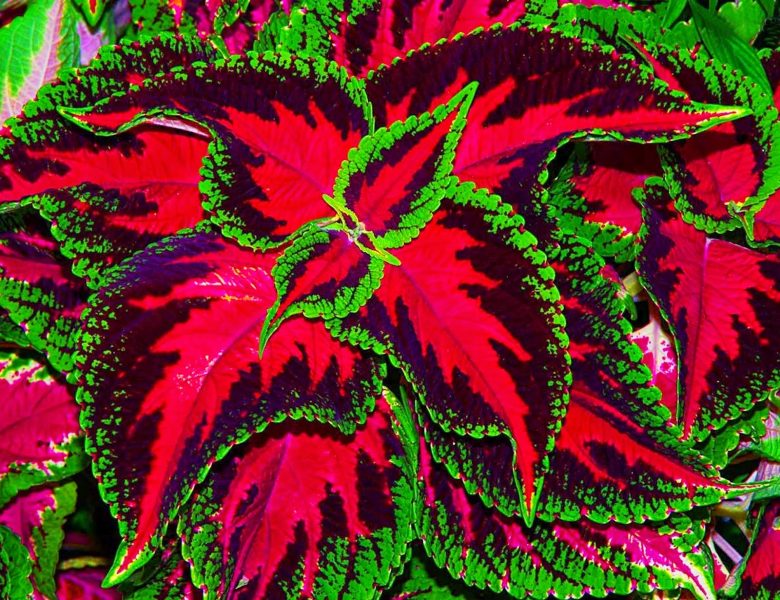
The most popular representatives of the species:
- Coleus "Black Dragon" - a variety distinguished by brownish-purple foliage with corrugated edges and pronounced red veins.
- Coleus "Wizard" is a cultivar that deserves attention due to the variegated colors of leaves framed by a border of different sizes and shades.
Coleus hybrid
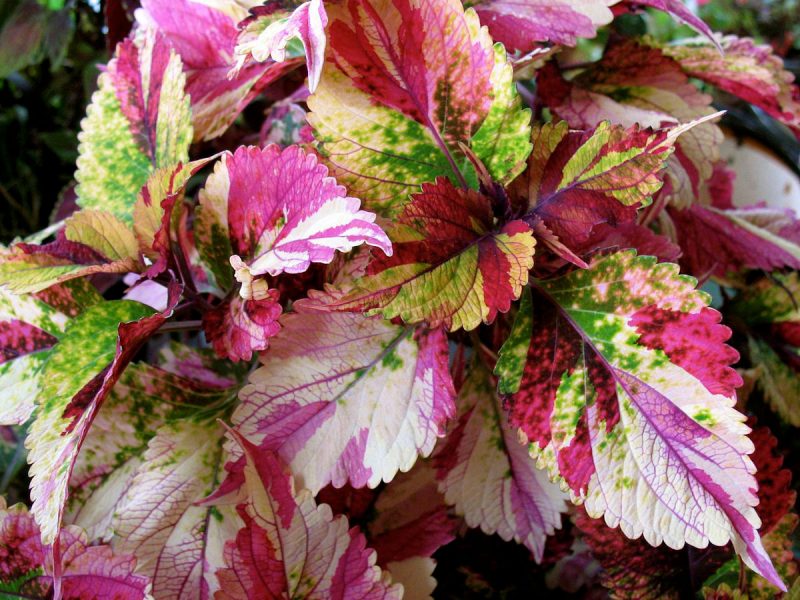
The species gained the greatest popularity in indoor floriculture, although sometimes it is also possible to meet it in the garden. A medium-sized plant capable of reaching a height of one meter. The color of elongated oval leaves with jagged edges may vary depending on the amount of light received. In the shade, the leaves of a representative of the tropical laura are green, but if the flower grows in sunny areas, the leaf plates acquire a burgundy color.
Coleus Renelt

Ampel form is grown in hanging pots used to decorate balconies, terraces and courtyards. The view is distinguished by petiolate heart-shaped leaves, which are decorated at the edges with multi-colored veins that give the look a special charm.
It is interesting:description of the plant goof
Growing Coleus from seeds at home
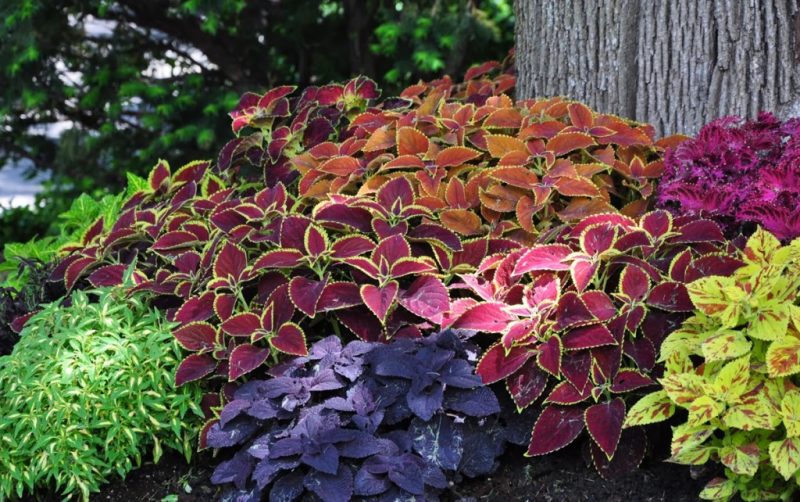
The most common way to get colorful and unpretentious bushes is to grow coleus from seeds, which are presented in flower shops in a wide assortment.
Soil preparation and tanks
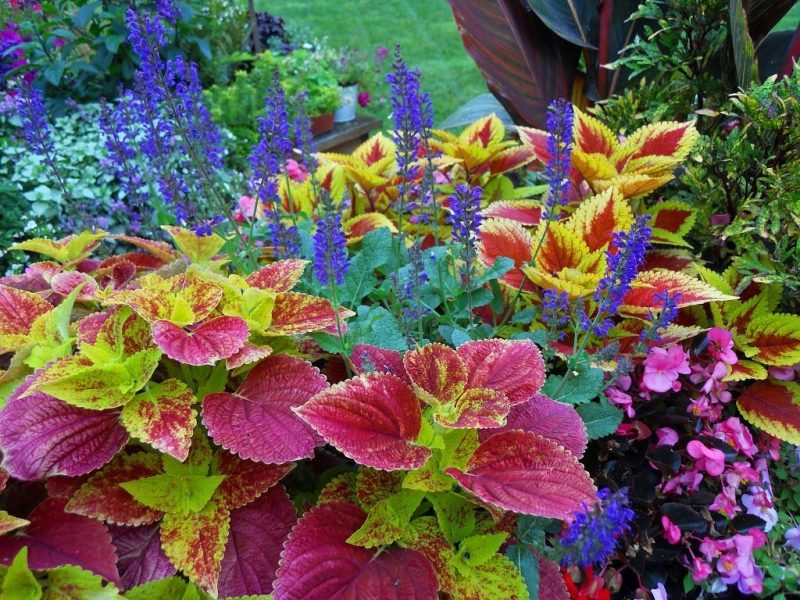
To get friendly and healthy seedlings, you need to choose the right dishes and soil:
- Soil - Coleus prefers fertile and light soil with a loose structure, which is prepared from garden soil, peat and sand in equal parts. Before use, the soil mixture is calcined in the oven.
- Capacity - a shallow box is selected for future seedlings.
Sowing seeds for seedlings
To obtain seedlings, sowing is carried out at the end of March according to the following scheme:
- A flat container is filled with a prepared substrate.
- Seeds are distributed on the surface of the soil, slightly pressed and moistened with a spray gun.
- The container is covered with glass and moved to a shaded, warm place where the substrate is kept in a slightly moistened state.
- After emergence, the glass is removed.
- The box moves to a diffused light window, where the temperature value varies between 17-19 ° C.
- When the first pair of true leaves forms in the seedlings, they dive into special cassettes for the development of the root system.
- When two pairs of true leaves are formed, the seedlings are planted in half-liter cups, where they are pinched for better branching.
Read also:outdoor care for dahlias
Coleus planting in open ground
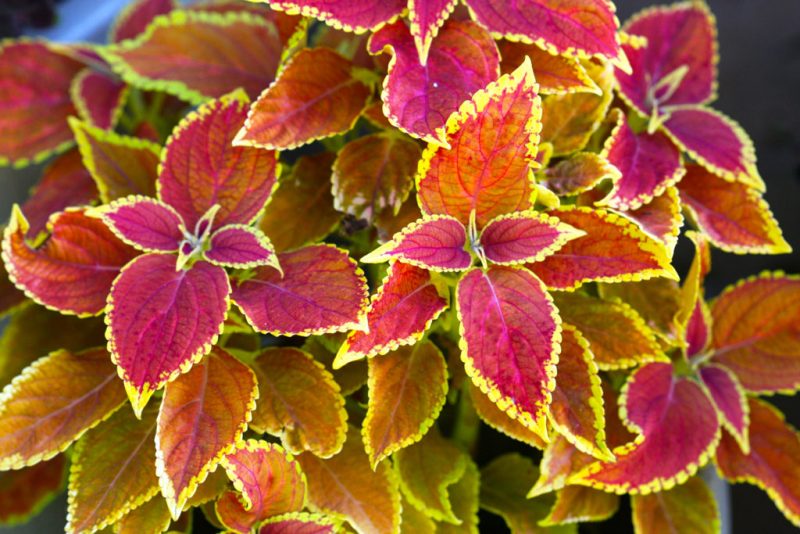
After the onset of stable heat, when the threat of return frosts passes, you can start planting seedlings in open ground:
- A sunny area is selected that is protected from the winds and slightly shaded during the period of solar activity.
- Dig holes with a size corresponding to the root system of seedlings, with a small distance from each other.
- Peat or compost is poured into each well to improve aeration and fertility.
- Then shrubs from cups are transshipped and sprinkled with the extracted earth.
- The soil is slightly compacted and watered.
Outdoor Coleus Care
The flower won the love of flower growers not only for decorative foliage, but also for undemanding care. To grow a healthy, lush plant, you will need to follow a short list of simple procedures.
Watering Rules
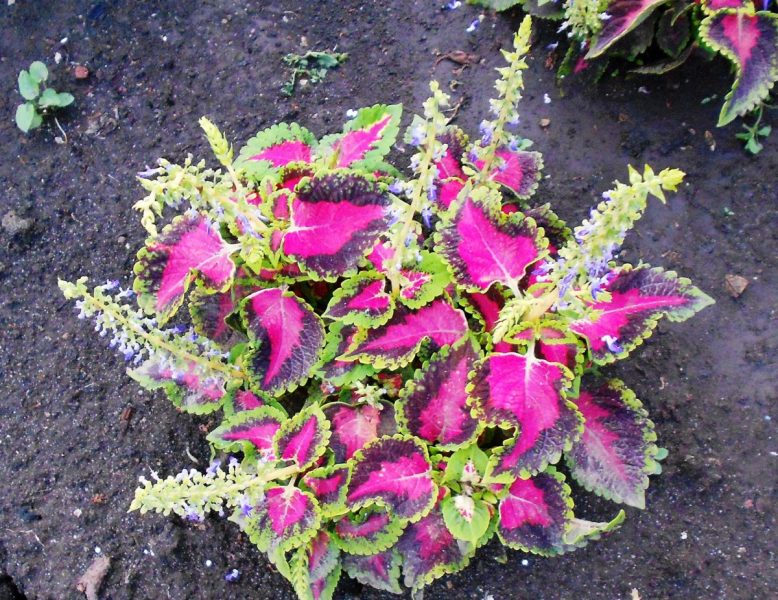
For the full development and preservation of decorativeness, an exotic flower needs abundant watering, in which the land should not completely dry out between new portions of water. Humidification should be carried out with settled water at room temperature, for which a barrel is suitable, where tap water will be collected, and then heated for a day.
Attention! When watering, it is necessary to be guided by a sense of proportion, since an excess or constant lack of moisture can cause the culture to dump decorative foliage, for which coleus is appreciated.
Tillage
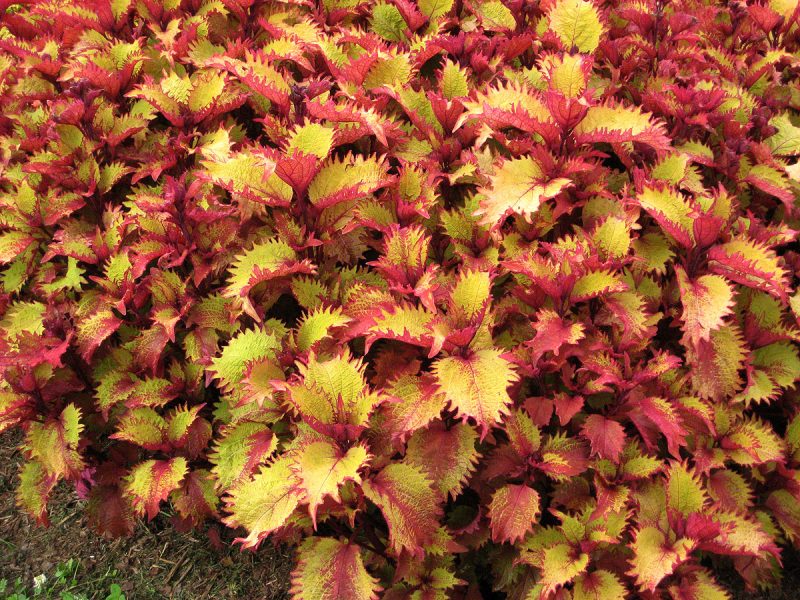
Periodically, the near-trunk circle under the bush must be loosened so as to prevent the formation of an impermeable crust.Weed control should be fought as necessary. As a rule, removing weeds when loosening, you will not need to take time separately for such a procedure.
How to feed the plant?
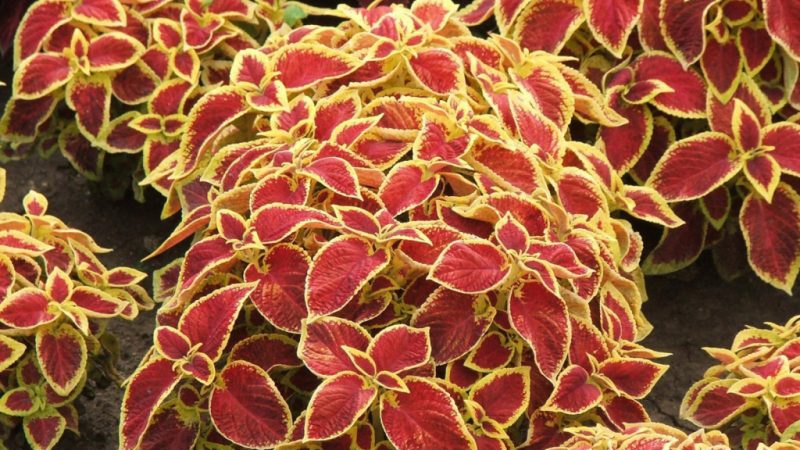
In order for the plant to intensively grow green mass, it should be fed weekly with liquid nitrogen-containing fertilizers during the growth period. A high nitrogen concentration will also help delay the onset of the flowering phase.
Cropping technology
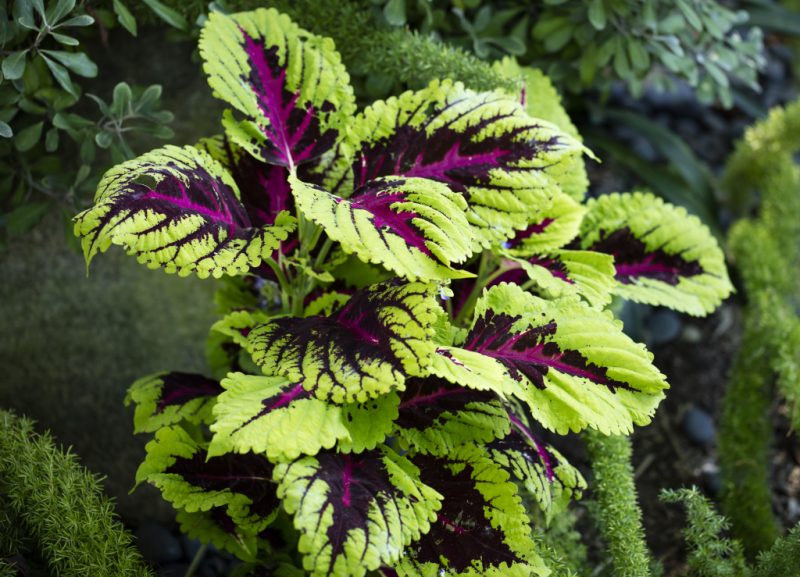
To stimulate branching and obtain a lush bush with variegated foliage, which will maintain decorativeness throughout the season, the coleus is cut and nipped:
- The first pinch is carried out in the seedling phase to give the flower a bush form.
- During the summer period, the coleus is trimmed three times, which allows you to form a thick and well-groomed crown.
- When flowers appear, flower stalks must be removed immediately so that the plant does not waste energy on flowering to the detriment of preserving the beauty of the leaves.
Pest and Disease Control
Coleus is a flower with strong immunity. However, it can also be attacked by pests such as aphids, spider mites and whiteflies. To protect the plant from dangerous insects, one should resort to spraying the culture with well-proven insecticidal preparations - Actellik, Appolo and other pesticides of a similar action.
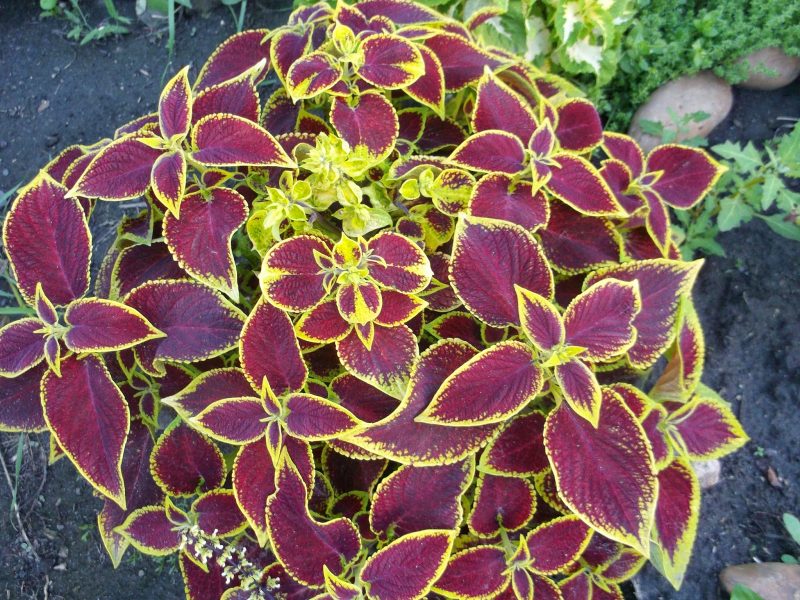
Some difficulties may arise with a lack of lighting, when the shoots of the coleus begin to stretch, the stalk is exposed, and it loses its decorative effect. Excessive lighting can also damage and discolor leaf blades. Due to improper care, the leaves fall off the plant.
Coleus in winter
The thermophilic plant from the tropics does not tolerate harsh winters, therefore it is grown in open ground as an annual plant.
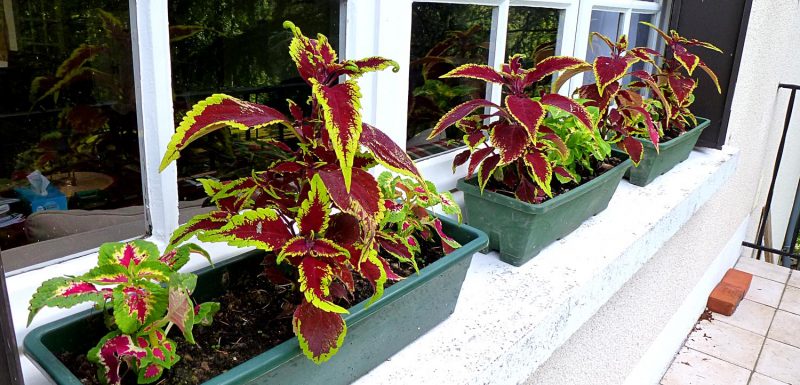
If the florist wishes, he can save the flower's life, but this will require:
- dig a bush from the garden;
- transplant the plant into a pot;
- put in a room with a temperature regime of 8-15 ° C;
- reduce watering and top dressing.
After the earth warms up enough and the risk of frost disappears, the flower can be planted back in the garden or on the flowerbed.
Coleus breeding methods
In addition to the seed propagation method, which was described above, there is a vegetative method of breeding using cuttings, when:
- From the apical shoots that are cut when cutting, 10 cm long cuttings are prepared.
- Leaf plates are removed from the bottom of the resulting stem.
- The resulting planting material is buried in a special soil mixture of equal parts of sand and peat.
- Landings are covered with plastic bottles.
- After 10-14 days, root formation occurs.
- New plants are planted in designated places.
Thus, a personal plot can be decorated not only with flowering plants. A decorative coleus with spectacular colorful leaves that does not require special care will be a great addition to any landscape composition.












